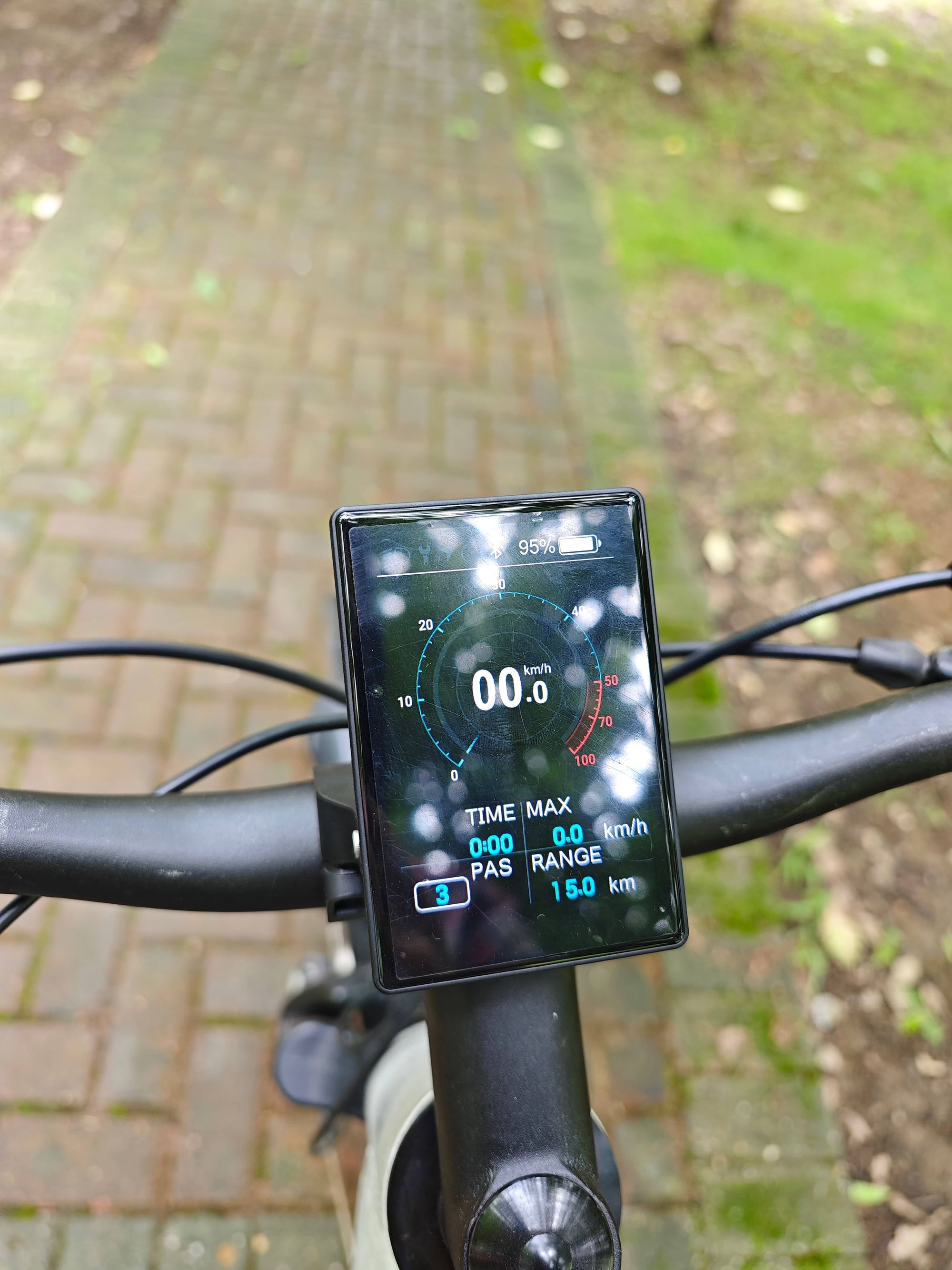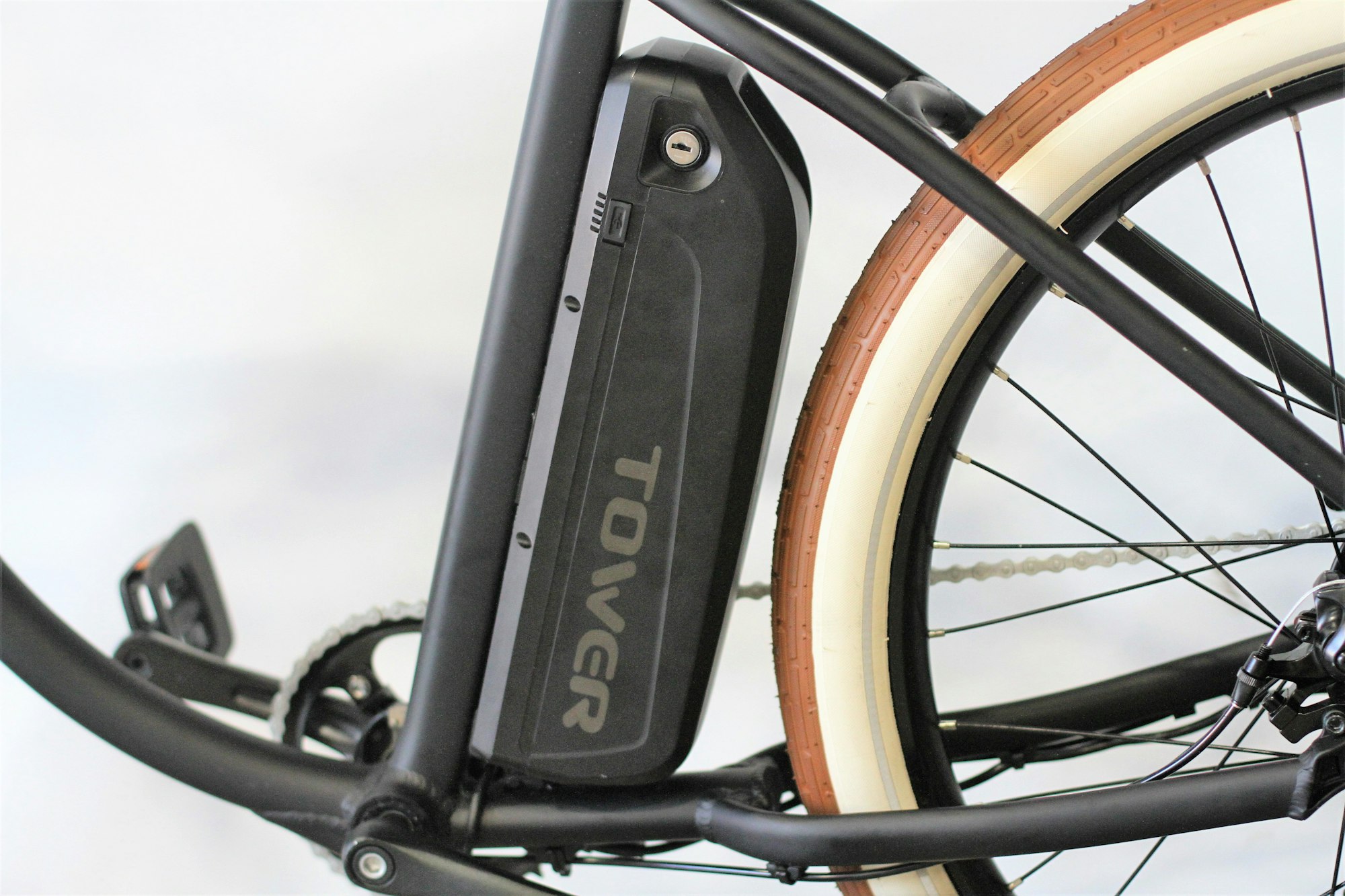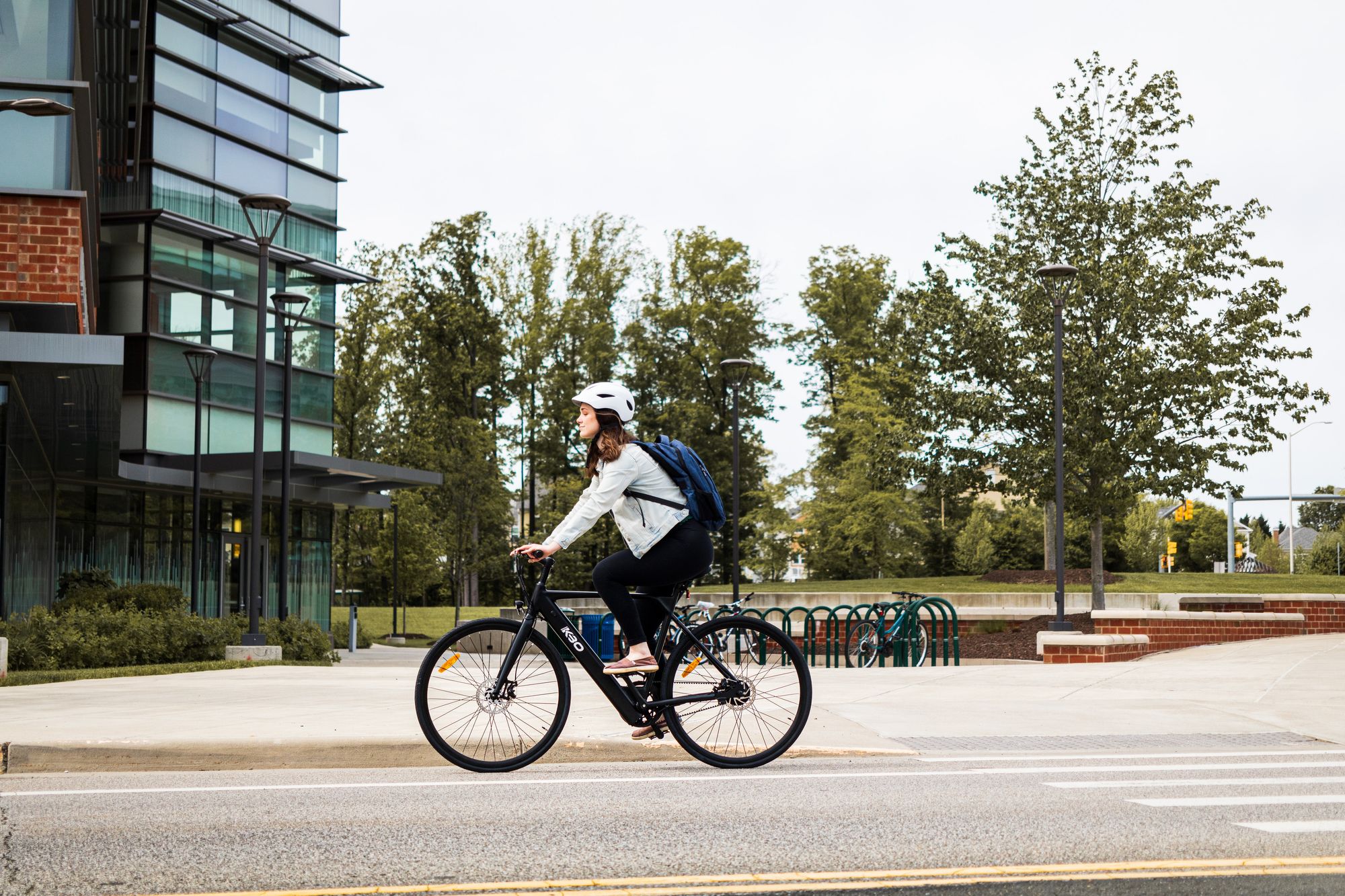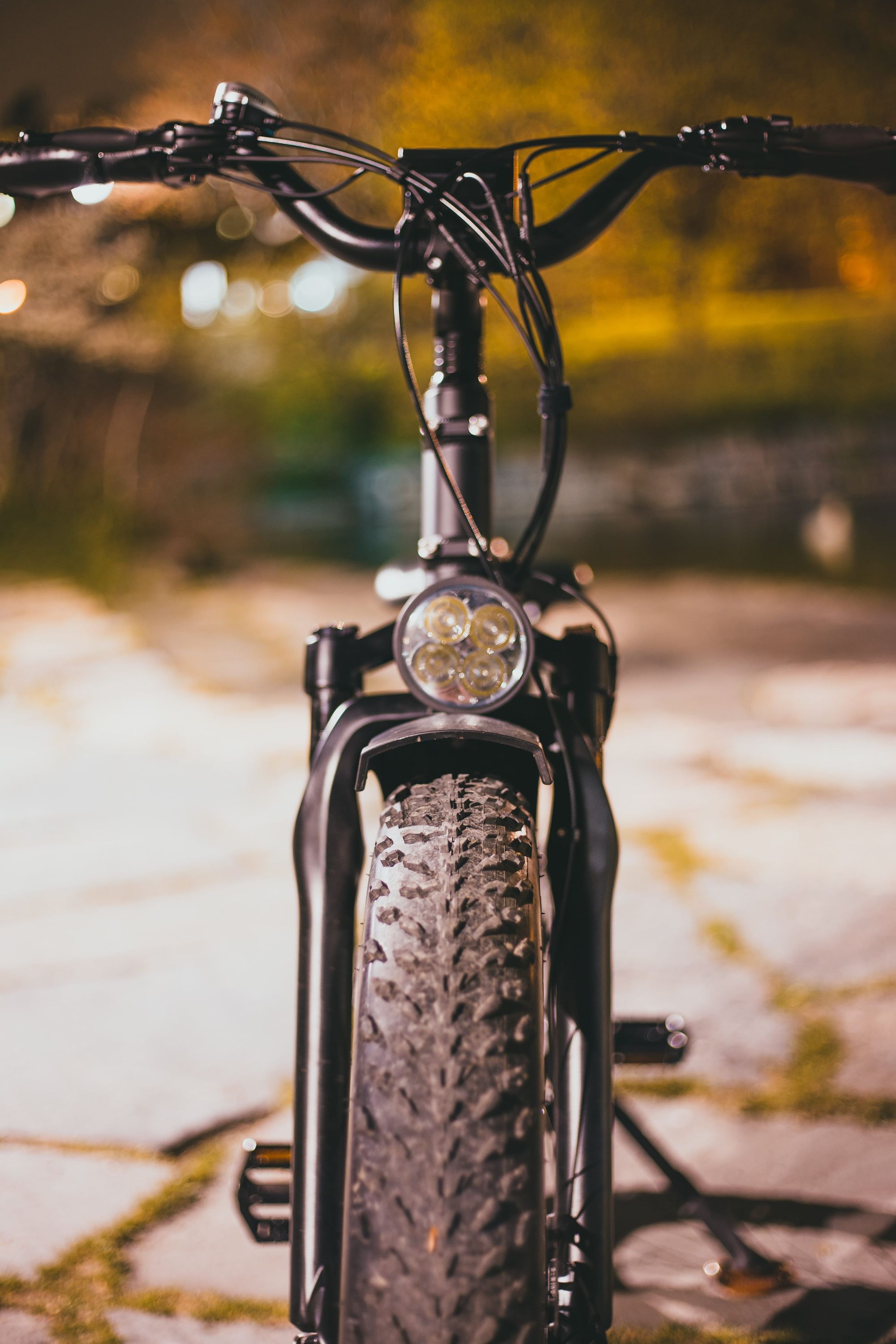Whether it's about the cost, the type of kit, or the overall performance, we're here to guide you through the ins and outs of transforming your beloved pedal bike into an electric dynamo.
Let's dive into what makes e-bike conversion kits a solid choice and whether they fit your cycling lifestyle.
What is an e-bike conversion kit?
While riding an electric bike might seem exciting, they can err on the expensive side. So, if you're not sure about paying what could potentially be thousands of pounds for one, you may want to consider a conversion kit.
An e-bike conversion kit lets riders transform their regular pedal bikes into an electric cycle. They do this by buying electric wheels powered by a battery and motor and swapping out the standard wheels. Or they fit a battery to the bike and power it through a "pedal-assist".
Regardless of the option selected, you can expect conversion kits to come with a motor, LCD display, battery, and all the necessary chains and accessories. After installation, you can reach a speed limit of 15.5 mph, the speed limit for e-bikes cycling on pavement in the UK.
How much do conversion kits cost?
Understanding the cost of e-bike conversion kits requires considering several factors, including the type of kit, battery options, and your bike's specific needs.
Overall, prices range from a few hundred pounds for a basic kit to nearly £1,000 for a comprehensive mid-drive kit with a high-capacity battery. It's essential to balance your budget with the quality of components like the electric motor and battery, as these can significantly impact your cycling experience and the durability of your converted e-bike.
Here's a detailed breakdown:
Conversion kit types and their prices
The cost varies significantly between different types of kits. Front and rear wheel kits are generally more affordable. Front-wheel kits especially tend to be cheaper due to more straightforward installation. On the other hand, mid-drive kits, which offer a more balanced ride and integrate with the bike's gears, are pricier and involve a more complex installation process.
Battery options and capacities
The price of a conversion kit can also fluctuate based on the battery's capacity and type. Larger-capacity batteries, which provide an extended range, typically cost more. Lithium-ion batteries are favoured for their efficiency and lifespan. Still, they are more costly than other types, like lead-acid batteries. Proper e-bike battery maintenance is vital to their longevity.
Impact of bike type
The type of your existing bike also plays a role in the cost. Road bikes might require less powerful motors, such as a 250-watt motor, potentially reducing costs. In contrast, mountain bikes may need more robust motors and batteries to handle rugged terrains, increasing the price.
Additional costs to consider
Professional installation is an additional cost, especially if you're uncomfortable with bike modifications. The complexity of the installation varies by kit type, influencing the total cost.
What are the 3 main types of e-bike conversion kits?
Understanding the various types of e-bike conversion kits is essential for cyclists looking to transform their traditional bikes into electric ones.
Each kind - mid-drive kits, front hub motors, and rear hub motors - offers distinct advantages and challenges. Here's a deeper dive into each type, outlining their specific features, components, and installation aspects.
Mid-drive kits
Mid-drive kits are centred around the bike's pedal area, offering an enhanced balance and natural riding feel. These kits directly integrate with your bike's drivetrain, efficiently delivering power, especially on varied terrains.
They are preferred for maintaining the bike's centre of gravity, making them ideal for casual and serious cyclists.
These kits often include an electric motor, a cadence sensor for measuring pedalling rate, and sometimes a speed sensor for tracking the bike's speed.
The installation can be intricate, often requiring adjustments to the bike's chain drive. While they might need professional help to install, many kits come with a detailed installation guide.
Mid-drive kit pros and cons
- Balanced weight distribution for a stable ride.
- Efficient power use, especially on hilly terrains.
- It is ideal for various terrain levels due to better integration with the bike's gears.
- Generally, it is more expensive than other types of kits.
- Installation can be complex, often requiring professional help.
- Adjustments to the bike's chain drive may be necessary during installation.
Front hub motors
Front hub motors are integrated into the front wheel, simplifying the conversion process. This type of kit is a go-to option for those looking for an uncomplicated transformation of their regular bike into an e-bike.
These kits usually feature an electric motor placed in the wheel hub and may include a speed sensor. They are compatible with various brake types, including rim and disc brakes.
Installation is generally straightforward, making it a suitable option for DIY enthusiasts. Many kits include an easy-to-follow installation guide.
Front hub motors pros and cons
- Easier to install, possibly without professional help.
- Suitable for a wide range of bike types.
- Simplifies the conversion process for beginners.
- Handling can be affected, especially on slippery surfaces.
- Weight distribution is not as even as mid-drive systems.
- It may not provide the same natural ride feel as other systems.
Rear hub motors
Rear hub motors are designed for the rear wheel, providing improved traction and balance. Those seeking a more powerful rear-wheel drive experience often choose this type of conversion kit. It is particularly effective for uphill cycling and offers a more natural weight distribution than the front hub motor.
Like front hub motors, these kits include an electric motor in the wheel hub and may feature a brake sensor for added safety. They are also adaptable to both rim and disc brakes.
The installation might be more complex due to the proximity to the bike's gears. Some technical know-how may be required, but a comprehensive guide is usually provided.
Rear hub motors pros and cons
- Improved traction is especially beneficial for uphill riding.
- More natural weight distribution than front hub kits.
- Enhances the bike's performance on inclines.
- Installation can be more complex due to proximity to gears.
- It may require adjustments to the bike's rear end.
- Slightly more challenging to install than front hub motors.
Where can I get an e-bike conversion kit?
A handy Google search for "e-bike conversion kits" should return plenty of options. They are in high demand right now, so don't be surprised if certain retailers have sold out.
You can get them on Amazon and eBay – though you may decide it's best to purchase one from a specialist cycle site, especially if it's your first time buying a conversion kit.
After purchasing a conversion kit, remember to protect your investment. We recommend exploring our electric bicycle insurance comparison page to find the best coverage for your newly converted e-bike, ensuring you're covered against potential risks and damages.
What's the performance like?
When converting your trusty bike into an e-bike, performance is critical. It's like giving your bike a new lease on life but with a few tweaks and adjustments.
Transforming a regular bike into an e-bike involves more than just strapping on a motor and a battery. The performance of your new e-bike will largely depend on how these new components harmonise with your bike's original setup.
Let's break down how potential speed, quality of electronic components, and overall build quality can influence your ride.
Potential speed
Converting to an e-bike can significantly increase your bike's speed, bringing a new level of exhilaration to your rides. However, this speed boost necessitates enhanced control to ensure safety and stability during your rides.
Quality of electronic components
The performance of converted e-bikes heavily depends on the quality of the electric components. High-quality motors and batteries offer efficiency and durability, smoother acceleration, and consistent power delivery.
Overall build quality
The build quality of the conversion kit is crucial. Superior components ensure the added weight is well-distributed, maintaining balance and handling. Conversely, lower-quality kits may lead to a cumbersome and less responsive ride.
What are the safety risks associated with e-bike conversions?
When converting your bike into an e-bike, safety is paramount. Ensuring your bike is compatible with the e-bike conversion kit is the first step. Professional installation by a trusted retailer is highly recommended for safety and reliability.
It's also important to consider the added weight from the conversion kit.
A common misconception is that electric bikes are too heavy. Still, with a fitting kit and proper installation, your bike can maintain its handling and performance efficiently.
Battery size and bike compatibility
The size of the battery must be appropriate for your type of bike. A mismatch in battery size can lead to an imbalance, putting undue stress on the bike's frame and components.
Ensuring that your bike can safely store and protect the battery is crucial. A poorly secured battery can become a hazard, particularly if it becomes loose during a ride or is exposed to external elements that could lead to overheating or damage.
Monitoring battery and charge levels
Regularly monitoring the battery and charge levels is essential for safe e-bike operation. This helps maintain the battery's health and prevent situations where you might be stranded with a depleted battery.
Avoid overcharging the battery, as this can lead to reduced battery life and, in some cases, potential safety risks. Using a quality charger and adhering to manufacturer guidelines is key to maintaining battery health.
The importance of e-bike insurance
Investing in specialist electric bike insurance is wise once your bike is converted. This insurance can offer protection against theft, battery damage, and other loss or damage, providing peace of mind and financial security.
Are e-bike conversion kits environmentally friendly?
E-bike conversion kits can be a more environmentally friendly alternative to manufacturing new electric bikes. This is primarily because converting an existing bike leverages and extends the life of materials and resources already used in the bike's manufacturing, thereby reducing the need for new resources and the associated emissions.
Efficiency of single-charge batteries
The efficiency of single-charge batteries in e-bike conversion kits contributes significantly to their environmental friendliness. These batteries often require less energy for a full charge while providing enough power for most daily needs, reducing energy consumption and carbon footprint.
Carbon footprint reduction
Research from the University of Oxford's Transport Studies Unit highlights the carbon-reducing impact of active mobility. The study found that switching just one daily trip from driving a car to cycling can reduce an individual's carbon footprint by about 0.5 tonnes over a year, representing a substantial share of average per capita CO2 emissions.
In urban European contexts, increases in cycling and e-biking have been shown to significantly lower carbon footprints, even with a high incidence of walking and cycling.
Comparative CO2 emissions
The study also noted that the average per capita CO2 emissions from transport ranged between 1.8 tonnes per person per year in the UK to 2.7 tonnes in Austria. This starkly contrasts the emissions savings achieved through active travel, further emphasising the environmental benefits of e-bikes and conversions.
Active travel and CO2 reduction
Another key finding of the study was that those who regularly cycle have 84% lower CO2 emissions from all daily travel compared to non-cyclists, demonstrating the significant benefits of active travel for reducing carbon emissions.
Are e-bike conversion kits worth it?
E-bike conversion kits are worth it, but it depends on your cycle type and budget. If you already have a high-end regular cycle worth thousands of pounds, upgrading with an e-bike conversion kit is worth it, as you don't want to change your bike.
However, cheaper e-bike options are coming to the market as they grow in popularity. That means you can pick up entry-level ones for around £500, which could be even more affordable than a conversion kit.
Consider the chart below:
Summary: E-bike conversion kits
Ebike conversion kits offer diverse solutions for every type of cyclist. Whether you're riding a top-tier bike and looking to preserve its essence or a budget-wise cyclist seeking an economical upgrade, these kits are a versatile and customisable choice.
There's something for every ride style and bike type, with options like mid-drive and hub motors. And for those with a green mindset, converting your current bike is a step towards sustainable cycling.
Whether you're looking to electrify your current ride or explore new options, e-bike conversion kits are an innovative, adaptable choice in the ever-evolving cycling world.
TRY OUR E-BIKE INSURANCE
Get covered for theft, accidental damage, full battery cover, loss and more. Try our 5-star rated e-bike insurance. It's e-bike insurance, and then some.






